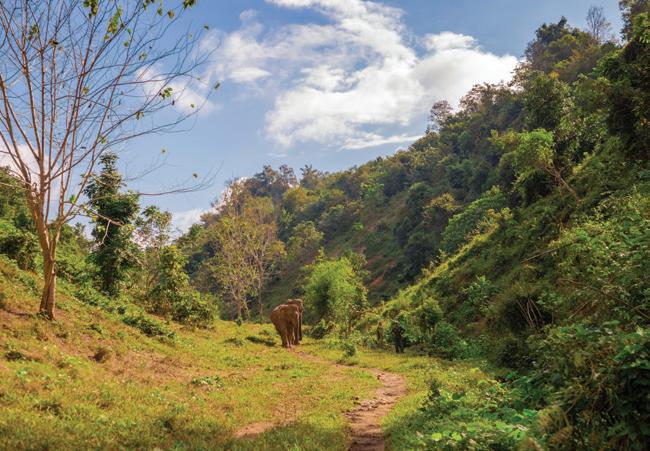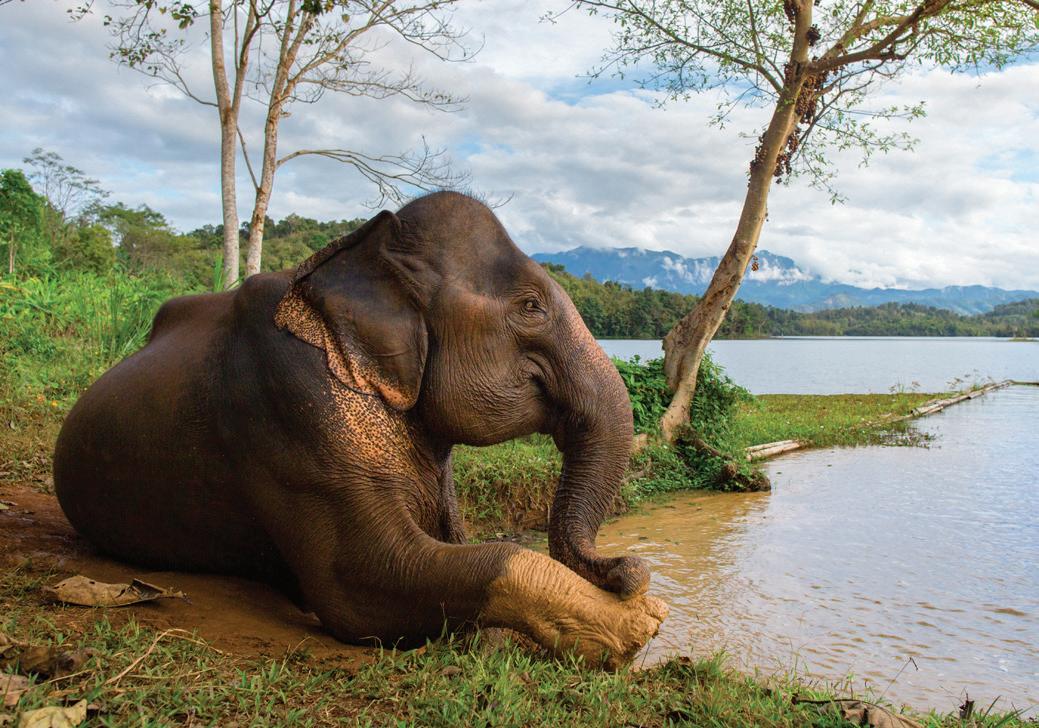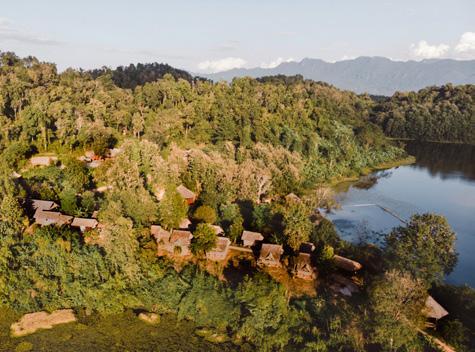
6 minute read
The Elephant Conservation Center
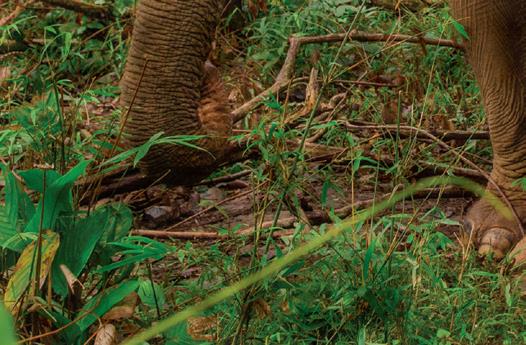
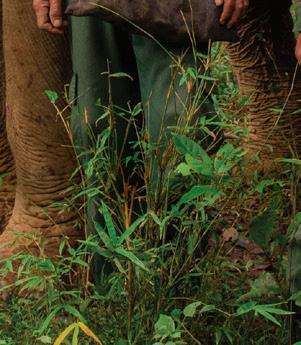
Advertisement
Caring for elephants is a jumbo task.


TEXT BY CLAIRE BOOBBYER PHOTOGRAPHS BY PAUL WAGER / ECC / TIBOSTUDIO
Mahouts at the ECC are among the most knowledgeable in Laos
On a bulge of land on the Nam Tien Lake in remote northwestern Laos is a retreat for elephants, many rescued from punishing logging work. The 34 elephants, including three babies, spend their days eating, bathing, and training to undergo health checks, while scientists contemplate their future.
The Elephant Conservation Center established in 2010, but whose team has been working for the protection of the Asian elephant since 2001, invites visitors to observe these diminutive pachyderms on their own turf. They were also recently granted the Conservation Gold Award by Asian Captive Elephant Standards, an independent auditing service for elephant-based tourism. So I signed up for a three-day program to walk with the elephants, observe their habits, prepare their food, and get a fast-track education about these endangered animals. And, thanks to a new fast road from Luang Prabang to the center in Sayaboury province, plus door-to-door service provided by the ECC, the trip was seamless end to end. Laos, once known as “the Land of a Million Elephants” today faces a critical situation: only around 400 captive elephants remain and around 300 survive in the wild.
Over coffee, in the center’s open-sided restaurant our guide, Mr. Pong, explains that wild Asian elephants face existential threats due to loss of habitat through deforestation, and poaching: elephants are in high demand for their skin, bone, and tusks. And captive elephants, once working in the logging industry are now unemployed, as the government outlawed logging in 2016. There are few safe natural habitats left for Elephas Maximus. Too few babies are being born, too. “Historically, mahouts didn’t want their female elephants to get pregnant as they can’t work for all 22 months of gestation,” Mr. Pong tells us “but the ECC is trying to change that with a new breeding program to ensure the future of the Asian elephant in Laos.” While elephants spend 17 hours a day eating 200 kg of plants and gulping 80–200 liters of water, we humans have more regular dining hours. We hiked over a jungly hill for our lunch in a bungalow overlooking a secluded corner of the lake. In the distance, we heard trumpeting and turned to see several elephants stuffi ng banana trees into their mouths. The group snorted and dribbled, and fi ve-year-old baby Do Khoun Meuang squealed before sinking completely into the water. It was magical to watch.
Back at camp, we examined outdated instruments, training hooks to persuade the animals to move onetwo ton logs long distances each day, and howdahs which used to carry humans on elephant backs,
before going on to meet vet assistant Mr. Kan at his training station outside the ECC’s health clinic. Here elephants are taught how to lift their foot, step on scales, and open their mouths for check-ups using “positive reinforcement” techniques.
Behind the clinic, an elephant skeleton towered over us, and Mr. Kan used the mammoth display to help deliver a class in unusual facts: elephants sport three eyelids like crocodiles; their teeth are replaced six times over their lifetimes; their penis weighs 27 kg, and is a meter long. My mind boggled.
Visitors on the three-day stay watch Mr. Kan at work with his trainees: he slaps the behind of female Mae Khoun Two so she lifts her tail; and he checks her mouth, tusks, and ears. She doesn’t seem to mind as she’s trunk-deep in a food basket while Mr. Kan fusses.
This training must help when visitors are allowed to approach. In a teak patch, below the clinic, we’re invited to get a close-up view of the fascinating wobbly lower lip. The sound of banana stalk being crunched, watching the gaping mouth, hairy chin, candy pink inner lip, pink speckled ear tips, long eyelashes, and wrinkled elbow skin – just like ours – before they meander down to the lake to bathe is all grippingly interesting.
We also need freshening up, and head to settle into our thatch-roofed bungalows with gorgeous lake views. From my terrace, I watch a deep rose-pink sunset; framed by bamboo sprays, sink behind the hills as kayakers’ strokes wrinkled the glassy sheen of the lake below.
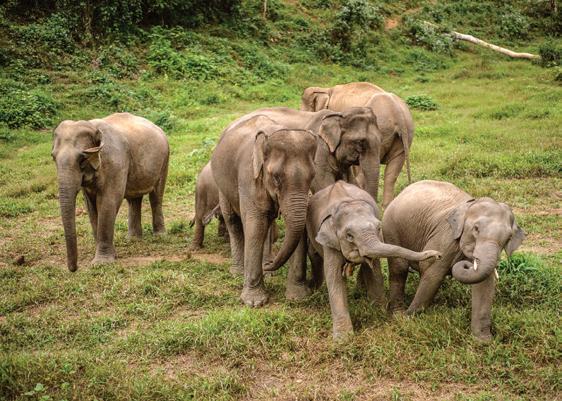
GETTING THERE The Elephant Conservation Center is located in Sayaboury Province. Transfers from Luang Prabang are available.
MORE INFO Support the ECC through Eat like an Elephant: look for restaurants across off ering vegetarian menus with proceeds devoted to the Center: elephantconservationcenter.com/eat-likean-elephant
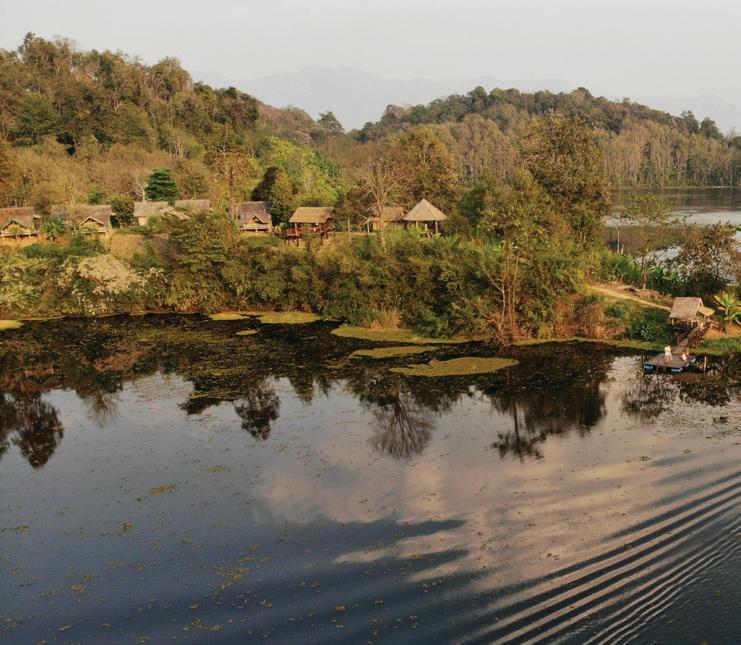
Before a communal dinner of rice noodle soup, Spanish biologist Anabel López Pérez talked to our group about the future of Asian elephants in Laos. “If we don’t change the situation, there’ll be no Asian elephants in Laos in 50 years,” she says. “If we want to save the elephants, we have to save the forest. We are not magicians…but the fi ght starts today.”
Part of that fi ght involves releasing elephants back into the wild but before that can happen elephants must socialize together. We witnessed this on our next morning. After a hike over hills walking behind the elephants that step over huge piles of turd and unleash waterfalls of piss, we watch eightmonth pregnant Mae Kham Ohn stand shoulder to shoulder with Mae Ven and Mae Khian. They poke trunks into each other’s mouths to check each other out, trumpet, purr, growl, and scratch with their trunks and chin. It was hypnotic, and the highlight of my trip being able to watch them bonding from just a few feet away.
On our last morning, we helped prepare sensorial enrichment – papaya, rice, pumpkin, fl owers, bananas, and salts – a technique that reduces stress and encourages new elephants to socialize. We hide food under wood, in trees, and on poles in an enclosure, then observe the animals from an observation post as they tear up tires and planks for the nosh.
It was a privilege to take part in the center even only for a few days. As Mr. Pong reminded us: “The ECC’s approach – ecotourism for working elephants – is a good solution, to safeguard the animals’ future.”
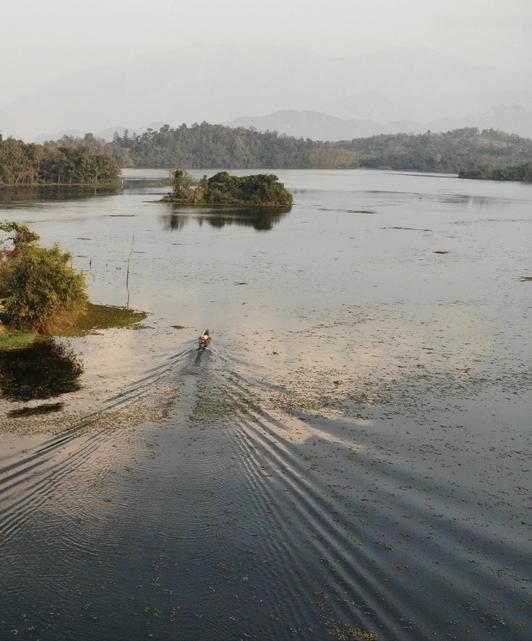
她说:“如果我们不改变现状,那么50年后老挝就不会有亚洲象了。” “如果我们要拯救大象,就必须拯救森林。这个目标不会马上实 现……但是必须从今天就开始改变。” 该保护中心计划将大象放回野外,但在此之前,大象必须在这里一 起社交。我们在第二天早晨目睹了这一场景。跟随大象在后山丘徒 步,我们看着怀孕的两头大象Mae Kham Ohn与Mae Ven和Mae Khian并肩站立。它们将树干戳入彼此的嘴巴以相互检查,并用树 干和下巴互相刮擦。在几英尺之外看着大象们互相交流,交朋友也 成了我这次旅行的亮点,那真是太美了。 虽然参加保护中心的活动只有几天,但是非常荣幸之至。正如庞先 生提醒我们的那样:“ 大象保护中心的保护方法是:把大象做为主 题的生态游。这是未来一个很好的保护动物的解决方法。” 到达: 大象保护中心位于沙耶武里省。提供往返琅勃拉邦的接送服务。 elephantconservationcenter.com
2
大象保护中心 照料大象是一项艰巨的任务 翻译 : 尹航 图片来源: PAUL WAGER / ECC / TIBOSTUDIO
在老挝西北偏远地区的南田湖畔有一处大象的隐居之所 (大象保护中心),许多大象是从艰苦繁重的伐木工作中 获救之后来到这里生活的。这里有34头大象,其中有3个 小象宝宝,每天在这里饮食,戏水,检查身体,它们未来的 安排就交给这里的科学家和全社会去思考了。 大象保护中心成立于2010年,团队自2001年以来一直致 力于保护亚洲象的工作。最近,团队还获得了亚洲圈养 大象标准的保护金奖,亚洲圈养大象标准是一个专门针 对以大象为旅游业务的独立监管服务机构。我报名参加 了为期三天的旅行安排,与大象同行,观察它们的生活习 性,了解这些濒临灭绝的动物,并为它们准备了食物。 老挝曾经被称之为“万象之国”。如今大象面临着严峻的生存 问题:具统计老挝现在仅存约400头圈养大象,300头野象。 在保护中心的餐厅,我们的向导庞先生解释说,野生亚洲 象由于砍伐森林和偷猎而丧失了栖息地,因此面临着严 重的人为造成的威胁,而且大象的皮肤,骨骼和象牙在市 面上有着很高的需求。曾经在伐木业工作的圈养大象现 在已经失业,因为政府在2016年宣布了伐木为非法行为。 目前几乎没有安全的自然栖息地供大象使用,而且新生 的大象宝宝也很少。我还了解到,大象每天要进食200公 斤的植物,喝80-200升水,耗时近17个小时! 我们深入森林到大象生活的区域徒步,并在可以俯瞰湖 泊小屋里午餐。在忙忙碌碌的照顾和了解大象中,度过了 充实的一天,现在终于可以回到小屋放松一下,欣赏湖 景。在阳台上,我看到了美丽的日落,皮划艇荡漾在洒满 余晖的湖面。 在集体米粉晚餐之前,西班牙生物学家安娜贝尔•洛佩 斯•佩雷斯(AnabelLópezPérez)向我们小组介绍了亚 洲象在老挝的未来。 4
5 3
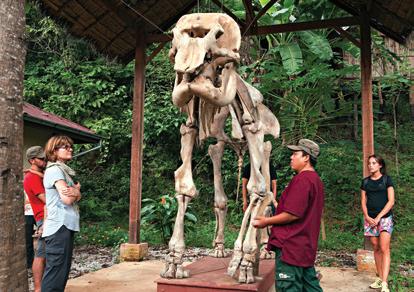
1. Forming long lasting herds of elephants is ECC's most pressing goal 2. Nam Tien Lake. In the background, "Phou Xang", the Elephant Mountain 3. ECC's veterinarian Mr. Kan explaining elephants' anatomy 4. Mr. Kan performing care on a new rescued elephant 5. ECC off ers over 6,000 ha. of pastures to 34 elephants
